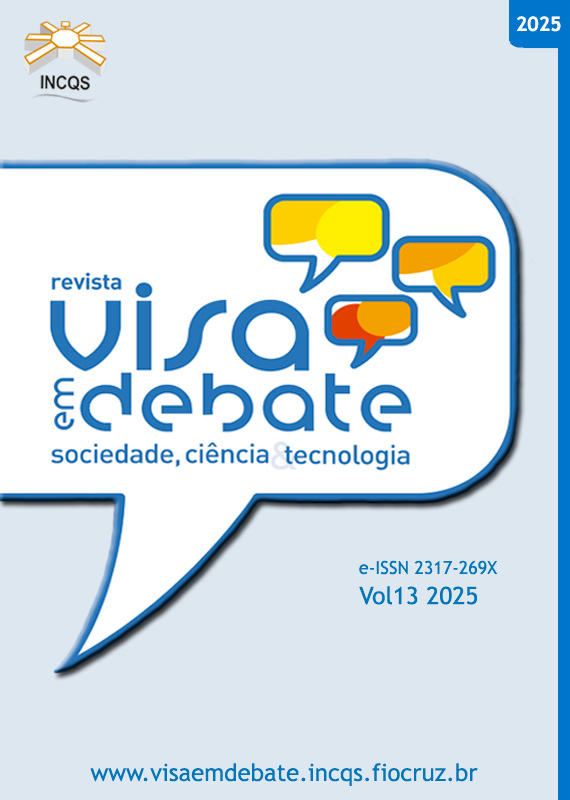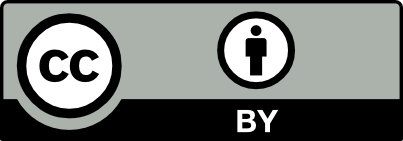Use of the Traffic Lights color system adapted as a teaching resourcefor the adequacy of good handling practices in butcher shops
Vigil Sanit Debate, Rio de Janeiro, 2025, v.13: e02329 | Published on: 27/08/2025
DOI:
https://doi.org/10.22239/2317-269X.02329Keywords:
Food, Good Handling Practices, Hygiene, Food Handlers, Traffic Light SystemsAbstract
Introduction: To reduce health risks and increase food preservation time, the implementation of Good Handling Practices (GHP) is mandatory in food processing and handling establishments. Failures in GHP have been attributed to the low effectiveness of training programs provided to food handlers. Objective: To verify whether the use of the Traffic Light-type color system, adapted as a didactic resource, can be used by butcher shop employees as a learning facilitator in the adoption of good food handling practices. Method: The hygienic-sanitary compliance of each of the five butcher shops (units) studied was evaluated before and after the introduction of the color system used in the training of food handlers. Initially (“before”), the handlers received a traditional lecture-based GHP course, and the environment was assessed using a checklist for four consecutive weeks. The evaluated items were classified as green for satisfactory (compliant) items, yellow for intermediate items, and red for unsatisfactory (non-compliant) items. In the “after” stage, the same course was conducted concurrently with the implementation of the color system in the units. To compare the results, a formula was developed, and statistical analysis was performed using the mean as a central tendency measure, with the significance of the difference evaluated by the paired Student’s t-test. Results: In Unit 1, compliance scores increased from 56.97 to 88.04; in Unit 2, from 78.67 to 87.06; in Unit 3, from 62.23 to 85.33; in Unit 4, from 65.69 to 87.70; and in Unit 5, from 60.53 to 88.81. Conclusions: The introduction of the Traffic Light-type color system influenced the attitudes and practices of food handlers, leading to a significant increase in hygienic-sanitary compliance in the studied butcher shop units.
Downloads
References
1. Secretaria Estadual da Saúde do Rio Grande do Sul. Portaria SES Nº 749, de 12 de dezembro de 2019. Regulamento técnico para as boas práticas na comercialização de produtos de origem animal em açougues e fiambrerias. Diário Oficial do Estado. 18 dez 2019.
2. Gottardi CPT, Mottin VD, Mürmann L, Saldanha CA, Schmidt V, Cardoso M. Avaliação das práticas de fracionamento de produtos de origem animal em supermercados em Porto Alegre. Acta Scient Vet. 2008;36(2):167-72. https://doi.org/10.22456/1679-9216.17280
3. Teixeira DA, Hott RC, Honorato M, Furtado HVV, Onofri L, Castro LA et al. Inquérito microbiológico e possíveis contaminações associadas aos procedimentos de manipulação de carnes comercializadas em açougues de Teófilo Otoni-MG. Rev Mult Nord Min. 2017;1(1):285-299.
4. Rossi P, Bampi GB. Qualidade microbiológica de produtos de origem animal produzidos e comercializados no Oeste catarinense. Segur Alim Nutr. 2015;22(2):748-57. https://doi.org/10.20396/san.v22i2.8642505
5. Barros MAF, Nero LA, Monteiro AA, Beloti V. Identification of main contamination points by hygiene indicator microorganisms in beef processing plants. Cienc Tecnol Aliment. 2007;27(4):856-62. https://doi.org/10.1590/S0101-20612007000400028
6. Agência Nacional de Vigilância Sanitária – Anvisa. Resolução RDC Nº 216, de 15 de setembro de 2004. Dispõe sobre regulamento técnico de boas práticas para serviços de alimentação. Diário Oficial União. 16 set 2004.
7. Martins GCG, Buchini JLC, Marzolla IP, Amorim AR, Gobetti STC, Marçal WS. Nível de conhecimento dos manipuladores de alimentos de origem animal sobre segurança alimentar: Londrina e região. Rev Bras Hig San An. 2020;14(2):185-95.
8. Kane L. Educators, learners and active learning methodologies. Int J Lifelong Educ. 2004;23(3):275-86. https://doi.org/10.1080/0260/37042000229237
9. Freitas CM, Freitas CASL, Parente JRF, Vasconcelos MIO, Lima GK, Mesquita KO et al. Uso de metodologias ativas de aprendizagem para a educação na saúde: análise da produção científica. Trab Educ Saúde. 2015;13(2):117-30. https://doi.org/10.1590/1981-7746-sip00081
10. Kilgour JM, Grundy L, Monrouxe LV. A rapid review of the factors affecting healthcare students’ satisfaction with small-group. Act Learn Met Teach Learn Med. 2016;28(1):15-25. https://doi.org/10.1080/10401334.2015.1107484
11. Gonzalez CD, Perrella NG, Rodrigues RL, Gollücke APB, Schattan RB, Toledo LP. Conhecimento e percepção de risco sobre higiene alimentar em manipuladores de alimentos de restaurantes comerciais. Nutr Rev Soc Bras Alim. 2009;34(3):45-56.
12. Ansari-Lari M, Soodbakhsh S, Lakzadeh L. Knowledge, attitudes and practices of workers on food hygienic practices in meat processing plants in Fars, Iran. Food Control. 2009;21(3):260-3. https://doi.org/10.1016/j.foodcont.2009.06.003
13. Castro FT, Barbosa CG, Tabai KC. Perfil de manipuladores de alimentos e a ótica desses profissionais sobre alimento seguro no Rio de Janeiro (RJ). Rev Bras Econ Dom. 2011;22(1):153-70.
14. Voos MC, Mansur LL, Caromano FA, Brucki SMD, Valle LER. A influência da escolaridade no desempenho e no aprendizado de tarefas motoras: uma revisão de literatura. Fisioter Pesq. 2014;21(3):297-304. https://doi.org/10.590/1809-2950/43521032014
15. Cunha DT, Stedefeldt E, Rosso VV. The role of theoretical food safety training on Brazilian food handlers’ knowledge, attitude and practice. Food Control. 2014;43:167-74. https://doi.org/10.1016/j.foodcont.2014.03.012
16. Duarte FM. Percepção de manipuladores de alimentos sobre risco sanitário [monografia especialização]. Brasília: Universidade de Brasília; 2017[acesso 25 mar 2022 ]. Disponível em: https://bdm.unb.br/bitstream/10483/18585/1/2017_FlaviaMorenoDuarte_tcc.pdf
17. Pagotto HZ, Espíndula LG, Vitória AG, Machado MCMM, São José JFB. Nível de conhecimento, atitudes e práticas dos manipuladores de alimentos em serviços de alimentação. Demetra Aliment Nutr Saúde. 2018;13(1):293-305. https://doi.org/10.12957/demetra.2018.30528
18. Arantes RS, Benevenuto WCAN, Benevenuto Júnior AA, Martins ADO, Martins EMF, Cruz WF. Características sociodemográficas e conhecimentos dos manipuladores de alimentos sobre as Boas Práticas, antes e após treinamento, em uma unidade de alimentação e nutrição. Aliment Cienc Tecnol Meio Amb. 2020;1(7):108-25.
19. Guimarães LA. Cor como informação: a construção biofísica, linguística e cultural da simbologia das cores. São Paulo:Annablume; 2000.
20. Kelly B, Hughes C, Chapman K, Louie JCY, Dixon H, Crawford J et al. Consumer testing of the acceptability and effectiveness of front-of-pack food labelling systems for the Australian grocery market. Health Prom Int. 2009;24(2):120-9. https://doi.org/10.1093/heapro/dap012
21. Cole M, Peek H, Cowen D. UK Consumer perceptions of a novel till-receipt ‘traffic-light’ nutrition system. Health Prom Int. 2019;34(4):640-7. https://doi.org/10.1093/heapro/day007
22. Sonnenberg L, Gelsomin E, Levy DE, Riis J, Barracloug S, Thorndike AN. A traffic light food labeling intervention increases consumer awareness of health and healthy choices at the point-of-purchase. Prev Med. 2013;57(4):253-7. https://doi.org/10.1016/j.ypmed.2013.07.001
23. Koenigstorfer J, Groeppel-Klein A, Kamm F. Healthful food decision making in response to Traffic Light color-coded nutrition labeling. J Publ Policy Market. 2014;33(1):65-77. https://doi.org/10.1509/jppm.12.091
24. Longo-Silva G, Toloni MHA, Taddei JAAC. Traffic light labelling: traduzindo a rotulagem de alimentos. Rev Nutr. 2010;23(6):1031-40.
25. Agência Nacional de Vigilância Sanitária – Anvisa. Resolução RDC N° 75, de 21 de outubro de 2002. Dispõe sobre o regulamento técnico de procedimentos operacionais padronizados aplicados aos estabelecimentos produtores/industrializadores de alimentos e a lista de verificação das boas práticas de manipulação em estabelecimentos produtores/industrializadores de alimentos. Diário Oficial União. 6 nov 2002.
26. Secretaria Estadual da Saúde do Rio Grande do Sul. Portaria Nº 78, de 2009. Aprova a lista de verificação em Boas Práticas para serviços de alimentação, aprova normas para cursos de capacitação em Boas Práticas para serviços de alimentação e dá outras providências. Diário Oficial do Estado. 30 jan 2009.
27. Stedefeldt E, Cunha DT, Silva Júnior EA, Silva SM, Oliveira ABA. Instrumento de avaliação das boas práticas em unidades de alimentação e nutrição escolar: da concepção à validação. Cienc Saúde Colet. 2013;18(4):947-53. https://doi.org/10.1590/S1413-81232013000400006
28. Tomich RG, Tomich TR, Amaral CAL, Junqueira RG, Pereira AJG. Metodologia para avaliação das boas práticas de fabricação em indústrias de pão de queijo. Cienc Tecnol Aliment. 2005;25(1):115-20. https://doi.org/10.1590/S0101-20612005000100019
29. Cunha AS, Wagner SA, Avancini CAM. Plano de ensino orientado por metodologias ativas de ensino aplicado em cursos de boas práticas de manipulação para serviços de alimentação. Vigil Sanit Debate. 2023;11:1-12. https://doi.org/10.22239/2317-269x.02137
30. Rennie D.M. Evaluation of food hygiene education. Brit Food J. 1994;96(11):20-5. https://doi.org/10.1108/00070709410074650
31. Tones BK, Tilford S. Health education: effectiveness efficiency and equity. 2a ed. London: Chapman & Hall; 1994[acesso 15 dez 2024]. Disponível em: https://citeseerx.ist.psu.edu/document?repid=rep1&type=pdf&doi=8a53ef486ce8757eb7007ca0ff2c0446ceda0019
32. Nieto-Montenegro S, Brown JL, Laborde LF. Development and assessment of pilot food safety education materials and training strategies of Hispanic workers in the mushroom industry using the Health Action Model. Food Control. 2008;19:616-33. https://doi.org/10.1016/j.foodcont.2007.07.005
33. Stan L. The traffic-light method in context evaluation: self-evaluation of preschoolers. Acta Didact Napoc. 2021;14(1):208-13. https://doi.org/10.24193/adn.14.1.18
34. Prensky M. A Teacher’s experiment: traffic lights or critical thinking? EducationWeeK, 17 set 2014[acesso 20 dez 2020]. Disponível em: https://www.edweek.org/education/opinion-a-teachers-experiment-traffic-lights-or-criticalthinking/2014/09
35. McCormick M, Harvey C. The traffic lights toolkit: a guide for practioners in higher education. Canterbury: Canterbury Christ Church University; 2018[acesso 15 jan 2022]. Disponível em: https://www.canterbury.ac.uk/learning-and-teachingenhancement/docs/traffic-light-toolkit/The-Traffic-Lights-Toolkit-A-guide-for-practitioners-in-Higher-Education.pdf
36. The English Classroom. Self Assessment with the Traffic Light System. The English Classroom blog. 2020[acesso 20 dez 2024]. Disponível em: https://the-english-classroom. com/blog/self-assessment-with-the-traffic-light-system/
37. Balcombe K, Fraser I, Falco SD. Traffic lights and food choice: a choice experiment examining the relationship between nutritional food labels and price. Food Policy. 2010;35(3):211-20. https://doi.org/10.1016/j.foodpol.2009.12.005
38. Marette S, Nabec L, Durieux F. Improving nutritional quality of consumers’ food purchases with traffic-lights labels: an experimental analysis. J Cons Pol. 2019;42(3):377-95. https://doi.org/10.1007/s10603-019-09420-5
39. Becker MW, Bello NM, Raghav PS, Chad P, Laura B. Font of pack labels enhance attention to nutrition information in novel & commercial brands. Food Policy. 2015;1(56):76-86. https://doi.org/10.1016/j.foodpol.2015.08.001
40. Quevedo del Pozo P. Exploring motivation in the teaching learning process: a clil approach with active teaching methods [monografía de graduação]. Palencia: Universidad de Valladolid; 2023.
Downloads
Published
Issue
Section
License
Copyright (c) 2025 Health Surveillance under Debate: Society, Science & Technology

This work is licensed under a Creative Commons Attribution 4.0 International License.
COPYRIGHT ALLOWANCE The author (s) hereinafter designated as the ASSIGNOR hereby assign and transfer, free of charge, the ownership of the copyrights related to this ARTICLE to the Vigilância Sanitária em Debate: Sociedade, Ciência & Tecnologia (Health Surveillance under Debate: Society, Science & Technology) – Visa em Debate, represented by FUNDAÇÃO OSWALDO CRUZ, established at Av. Brasil, nº 4365, Manguinhos, Rio de Janeiro, RJ, Brazil, CEP 21045-900, under the conditions set out below: (a) The terms and conditions set forth in this Agreement shall apply to the following: 1. The ASSIGNOR declares that they s(he) is (are) the author (s) and owner (s) of the copyrighted property of the ARTICLE submitted. 2. The ASSIGNOR declares that the ARTICLE does not infringe the copyrights and / or other property rights of third parties, that the disclosure of images (if any) has been authorized and that they s(he) assume(s) full moral and / or property liability for its content, before third parties. 3. THE ASSIGNOR assigns and transfers all copyrights relating to the ARTICLE to the ASSIGNEE, especially the rights of editing, publication, translation into another language and reproduction by any process or technique. The ASSIGNEE becomes the exclusive owner of the rights related to the ARTICLE, and any reproduction, totally or partially, is prohibited in any other means of publicity, printed or electronic, without prior written authorization from the ASSIGNEE. 4. The assignment is free and, therefore, there will be no remuneration for the use of the ARTICLE by the ASSIGNEE.






